Blockchain and scholarly publishing could be best friends
Abstract
All the power on the Internet belongs to companies such as Google, Facebook, and Amazon - largely because they control content discovery. Users return to them time and time again instead of browsing around the web like originally intended because the access mode is direct and trusted. Also, these developers have built clever technology and algorithms that keep users hooked - all while using what remains siloed information and data that is essentially provided by publishers who themselves have built websites, platforms, and apps with walls around users.
This paper attempts to demonstrate how Blockchain technology provides an opportunity to take back this power by decentralizing the Internet once again. It also offers the possibility to open up horizontal discovery on the web between publishers providing optimal discovery, while at the same time creating trust and transparency between publishers.
“It’s worth saying up front that this paper is partly a view of blockchain and the scholarly publishing world from the outside, so that’s where my starting point will be. Sometimes when you look at the world from the ‘outside in’ it’s easier to see what’s going on.
We’re going to take a look at what’s happening out in the world of technology and content.
The image below is taken from a book called The Four: The Hidden DNA of Amazon, Apple, Facebook and Google [1].

These companies are, to use a good software term, ‘eating’ the world. This can be seen clearly in digital content distribution: Over 75% of all web traffic is generated by just Facebook and Google. So, if you run a website, whether that’s in scholarly publishing or in the broader media, the likelihood is that the vast majority of your traffic comes via one of these platforms. That wasn’t always the case. Even six or seven years ago, about 70% of all traffic would come directly to websites. There’s been a big silent change in user behavior. Digital content distribution is now almost fully-intermediated by these platforms. That’s obviously also true in content sales. Amazon has taken a very dominant role in the space of selling content on the internet. But Apple is not far behind if you consider iTunes, Apple Music and the App Store. This is the reality we all live in today - whether we are in entertainment, or trade, or scholarly publishing.
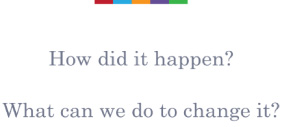
How did this happen? What might we be able to do to change it? There’s no doubt in my mind that blockchain will be part of these two discussions going forward.
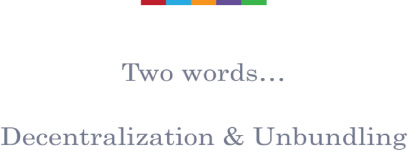
Two concepts are key here: decentralization and unbundling. Starting with unbundling, there’s a famous quote by Jim Barksdale: “There are only two ways to make money in business: One is to bundle; the other is unbundle [2]”.
If you look throughout most content categories, for example cable or academic publishing, the story has been one of bundling and unbundling. For a period of time we had a lot of unbundling, followed recently by a long period in which bundling content together into bigger repositories and services seemed to make sense, e.g. enterprise sales into libraries etc. What we’re seeing now with blockchain-based systems, and a growing technology around decentralization, is a bit of unbundling coming back again driven by barriers to distribution coming down rapidly.
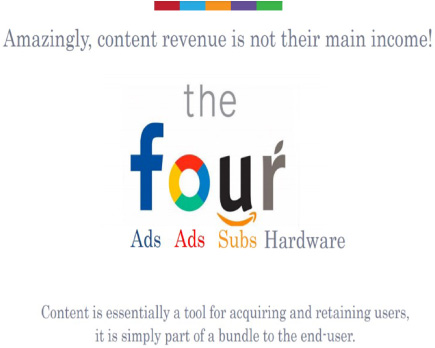
Interestingly enough, if you look at these four platforms, then you’ll see that content is the main source of income for precisely none of them. Content is a way for them to drive engagement and dominate audiences. That tells us something very interesting: content is still king. Great content still dominates the user experience and is a way of capturing and retaining users. Google and Facebook obviously use it to drive ad revenue. Amazon is using content more and more to drive Amazon Prime subscriptions, with currently 100 million paying subscribers.
The future of Amazon is a subscription business, not a digital store. It drives a rapidly-growing part of their business. Apple has lived off selling hardware, but has used content like iTunes to tie customers into their ecosystem and make them happy. Recently, they announced that they will be spending a billion dollars making video content with Oprah Winfrey and others to keep up with Netflix, Google, etc.
At Bibblio we work across three main sectors: media & publishing, the book & library world, and in what we call learning & development. A big part of the latter is, of course, scholarly publishers. What we see across the board is that subscription is rapidly becoming the way to pay for content, whether that’s music, movies or journals. This has a lot to do with friction - it is a way of removing it from the end user. The importance of this can be seen with micropayments - one of the chief reasons that we haven’t seen a model that really works is that it adds, rather than removes, friction. In this world, we have creators and consumers, and a line between them.
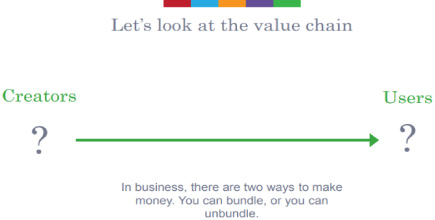
Publishers live in this world. Between the two endpoints you can create value for customers by packaging things together or splitting bundles up to make a more attractive proposition.
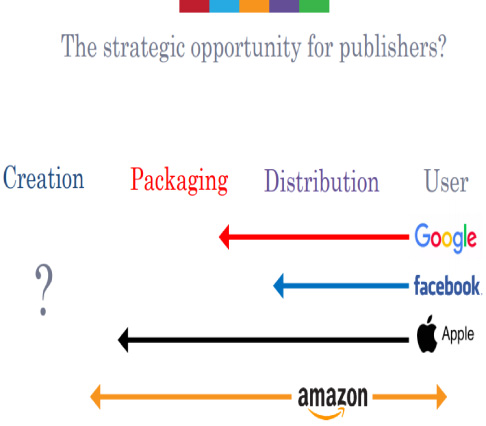
“Looking again at the four, it’s crucial to note that these companies have ‘won’ by owning the end user. If we assume a simple value chain here from creation to packaging, distribution and user. If you look at traditional publishers, then you see what they’ve been doing historically is packaging and distribution. And because book stores or libraries owned the user everything was fine. Amazon was the first to disrupt the publishing industry by taking over the user and distribution part - by disintermediating the bookseller. This meant that publishers had to share distribution with Amazon to sell and deliver their books. This helped Amazon to start to own the end user relationship. What we’re seeing more and more is that some of those companies are moving into packaging. Amazon has launched their own publishing company, where they want to leverage some of the data they are getting from users and distribution. We’re seeing this too at companies such as Netflix, where what people are watching is determining which content gets funded. Interestingly enough, if you look within the scholarly publishing world then there’s still not a lot of data flowing back from the user. Using those insights from the user experiences could begin to inform how to create and package better content. The bet from the Amazon and Netflix’s of this world is that this data will allow them to be more successful bundlers in the future than say, cable TV or physical malls, ever was.
The opportunity here is to leverage data and user convenience as a way to compete. One significant advantage that the scholarly world has, is that it has so far been more shielded from the disruption caused by the four than, say music and movies, have. That doesn’t mean that the same changes on a structural level aren’t coming, and things are opening up more and more. I think some of the clever companies in this space - Clarivate Analytics, for example, who bought Kopernio - are trying really hard to figure out how to give end-users a better experience when it comes to academic content. I think it’s fair to say that, on the whole, the user experience in scholarly publishing contains too much friction. One example of this is the number of companies offering a confusing array of subscriptions. Distribution is not the same as accessibility from an end-user point of view.
The uncomfortable truth is that often the easiest way to access something for a student or researcher might be illegally. We’ve seen from other industries that piracy starts to come down again when the value of using legal services goes up for users. Encouragingly, on the whole, people can’t be bothered to pirate if the alternative is to pay only $9.99 or $19.99 a month for a good service. There are two reasons why these services are appearing quite slowly in the scholarly world: one is that at the moment a lot of money is still being made on content sales, and subscription is a fundamentally new way of funding that content. We’ve also only just begun to see Open Access initiatives, but they’re now gaining ground all over the world. This still stands in contrast to the traditional packaging model of the publishing industry and represents one way in which decentralization can disrupt bundled business models.
The real opportunity for me, however, is with creators. As we discussed earlier, creators and content is still king. So why has no one strategically tried to focus on the creators and get them on their side? Build around them. It would position any organization that succeeded it as the true rival to the companies that are perceived as the biggest threat to this industry.
There should be a lot more focus on the creation process - on helping authors and researchers make better content, get more out of their content, and leverage their content better. Last week, I was visiting a startup in Berlin who are collecting all the content from academic conferences, like NFAIS, and making sure everybody has access to papers and materials before and after the event. This means that the people who arrange those conferences can begin to leverage all of that data to build a relationship with their audience. We can also get far more thoughts and ideas out into the world at a “pre-paper stage,” e.g. preprints. We have to recognize that the peer review process is still a very long process. There’s a lot that can be done in that process that’s better for the authors than it is at the moment.
There is a very famous picture of a young Afghan girl that appeared on the June 25, 1985 cover of National Geographic [3]. It’s common knowledge who published this photo. But the big question is ‘who was the creator?’ Who actually took the photograph? The answer is Steve McCurry. But hardly anybody knows that. The point is that this has been happening in publishing for many years. Even in the world of National Geographic it really became the publishing brand that benefited the most from a lot of this content, not the creators themselves. Bundling often has a leveling effect on creators. Everyone knows National Geographic for their famous photography, but very few people in the world can actually name a National Geographic photographer. As publishing companies in the past we haven’t necessarily done a great job of making the creators, the authors, the heroes of our story. We haven’t built a lot of tooling for them. We haven’t built a lot of insights or services for them. We just pay them and expect them to create. And typically we have taken their work and been the people who benefited most from that. If you want to position strongly for the future in terms of strategy, then building a platform that focuses on the creators is a strong idea.
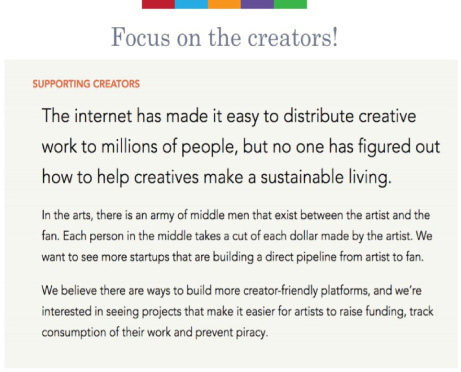
Y Combinator, an organization located in Mountain View, CA, USA, provides seed money for startups. In their most recent call for funding as shown in the mage above, they say “the internet has made it easy to distribute creative work to millions of people, but no one has figured out how to help creatives make a sustainable living [4]''. That’s not entirely true in the scholarly world because often you have a day time job, which means you at least have a sustainable living. However it’s still the case that a lot of the value that comes out of the academic content, not just monetary, but also in terms of insights and feedback, is not coming back to help the creators.
Reading on: “In the arts, there is an army of middle men that exist between the artist and the fan. Each person in the middle takes a cut of each dollar made by the artist. We want to see more startups that are building a direct pipeline from artists to fan. We believe there are ways to build more creator-friendly platforms, and we’re interested in seeing projects that make it easier for artists to raise funding, track consumption of their work and prevent piracy''. Take everything in this text, and replace ‘artist’ with ‘researcher’. A lot of the same things ring true: there’s an army of middle men who take a cut of the work made by the researchers and we are beginning to see startups, and particularly the ones helping researchers raise funding, track the consumption of their work and prevent piracy.
Across the content industries there’s more similarities than differences. Of course, academic content and journal articles are not the same as music and TV shows, but if you take the perspective of supporting creators, then I believe they can be used pretty interchangeably.
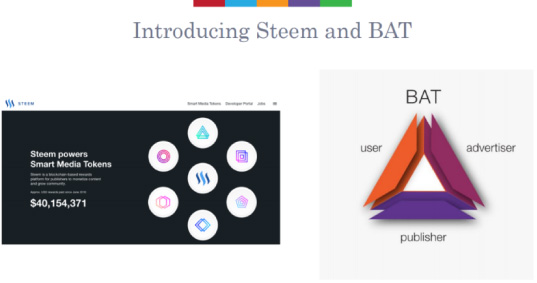
Tools have already begun to emerge in the media and publishing world which are essentially token-based systems that allow us to reward creators directly. Steem (see: https://steem.io/) and T (the Basic Attention Token [5] for blockchain-based digital advertising, see: https://basicattentiontoken.org/) are two of them.
In a recent article it was revealed that YouTube and Facebook are beginning to lose creators to blockchain-powered rivals [6]. So, even with the dominant market position of YouTube and Facebook, creators are actually leaving those platforms in increasing numbers, or at least supplementing them with direct-to-fan or direct-to-audience platforms where they can have more control. Famously, YouTube measured their success early days in the amount of content uploaded, as content drives audience. Loosing great content presumably has the opposite effect over time? LBRY (see: https://lbry.io/) is the most ambitious one that I know of. They are aiming to reward content creators directly. Anything from Hollywood films to college lessons. It’s styled as a media network ruled by you, and in this case “you” means both the creator and the audience. It’s the premise of one platform that directly connects these two sides in a digital marketplace of content. It’s interesting that the name LBRY indicates a broader play. If you go to a public library today, then a large part of what they offer is around movies and music as well as books: it is content as a whole.
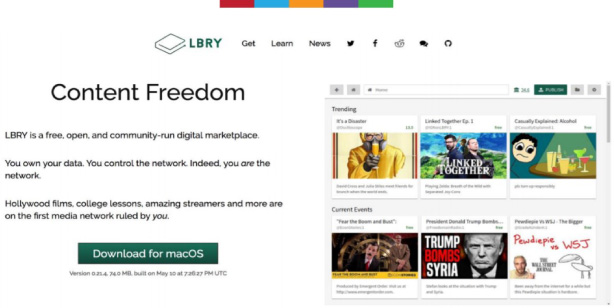
If you look at the publishing industry from the outside, one of the biggest challenges has been freedom to consume content easily and connect to the creator. It’s very telling that the book world is really the only platform or media type that doesn’t have a dominant subscription platform yet. Scribd (see: https://www.scribd.com/) in the USA have tried convincing publishers of this all-you-can-eat model, and so far haven’t been particularly successful. Are there ways to free up content to be portable and easily accessible to users while preventing piracy and improving monetization? I think this is where blockchain technology can come in - alongside bringing the two parties closer together. However, if the scholarly publishing industry doesn’t embrace it, it can be pressured by both more ambitious bundling and increasing unbundling options at the same time.
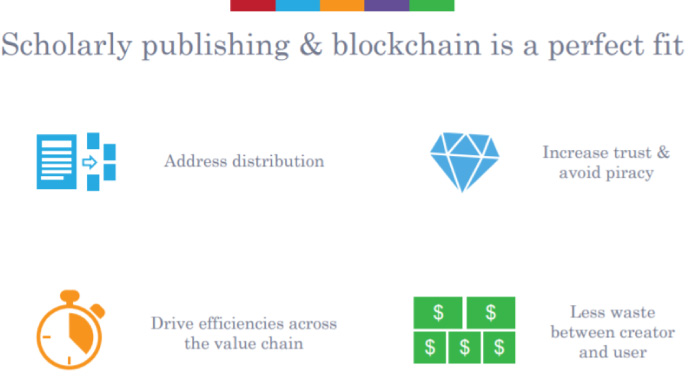
Blockchain enables us to address distribution challenges. We can track where the content goes, if it’s being changed or shared or monetized. This in turn helps to increase trust and avoid piracy. High levels of trust have helped the scholarly publishing world avoid some of the more dramatic challenges facing other parts of the content ecosystem up to now. It’s also been good at avoiding large scale piracy. These challenges are only going to increase in scope though, and blockchain technology could be a vital tool in helping to maintain the positive state of affairs.
Blockchain can also help drive efficiencies across the value chain. Attendees at the NFAIS conference on Blockchain and Scholarly Publishing that was held in May 2018 heard examples of how that can be done at the stage of funding for research, but that’s really just the beginning. The next area is around peer reviewing. Setting it up, getting it reviewed and published in journals, getting it out there in various versions. There are still many efficiencies that can be created from the first draft at a conference to the final peer reviewed paper.
Ultimately there’s the potential, as Y-Combinator said, to stop wasting so much money between the author and the end user. The majority of the money disappears in the delivery chain. This new technology gives us exciting options to create a more efficient economic ecosystem for scholarly content. But it is in some ways at odds with the existing publishing model. We may have to think differently about revenue to be successful in the future.
Companies who’ve historically made a lot of money from transactional sales, such as Adobe and Microsoft selling software, have successfully transitioned to a subscription model recently. This has helped them to avoid piracy and has created predictable and regular revenue. We’ve haven’t seen this change in scholarly publishing yet, but my money is on it happening eventually. In the UK we now have the first businesses that allow students to pay a monthly fee to access all of their books in university, so there are certainly people working on this problem. It isn’t a solution we have seen applied at a grand scale across the world yet, though. The current reality for most university students from bachelor level through to research is that you’re purchasing most of your content, or accessing it via an enterprise subscription through your institution, partly paid for by your tuition. And even that access can often be a quite laborious process. Systems are getting better at providing direct single sign on via library systems, but it’s still a real challenge.
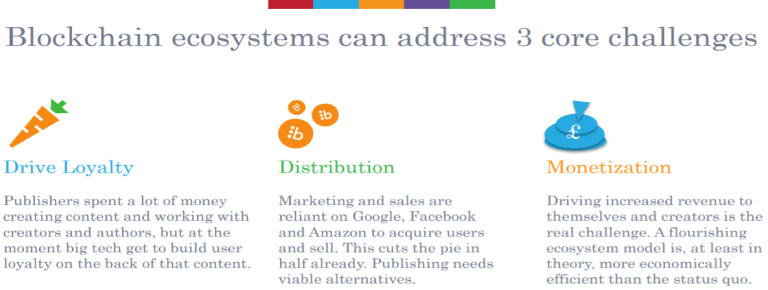
Increasing access is also crucial to unlocking the true value of scholarly content. Publishers spend a lot of money creating content. They also spend a lot of money around the content ecosystem: packaging, reviewing, designing, etc. Generally, scholarly publishing excels in creating very high-quality content, but it’s still the case that much of that content never reaches an end consumer. Around 30%--40% of all papers never get read by a single person.
I think there’s a tremendous opportunity here to build platforms that work better for both the researchers/authors and for the students and other end users of that content. Increased loyalty would certainly be one outcome. Some of these new platforms in the scholarly space that focus on providing easy access to content, whether legally or illegally, have certainly seen tremendous growth and loyalty from end users. It’s a trend we can’t afford to ignore.
Scholarly publishing would also benefit hugely from more control over distribution. A lot of sales also still go through the library or university book stores, but both are under increasing pressure. It’s never been more expensive to be a student. It’s still a significant challenge for publishing to rely on very powerful middlemen to reach their audience. An interesting case study is the primary and secondary school world where Google Classroom is beginning to source content from various open access repositories. Because they are the default platform, which millions of teachers and students are using every day that open access content suddenly has a direct route to audiences that is helping it scale. This is happening increasingly quickly, and I think it will be a real challenge in the longer run to scholarly publishing too.
Going back to the Four, could it be that a significant part of the scholarly publishing industry is not selling content – but delivering services. To content service companies, the content is a way of acquiring and retaining users rather than the main way of deriving revenue. That puts publishers at a disadvantage if content is still their lifeblood in terms of revenue. Because a services company can afford to not make money from it. They monetize users, not content.
The last thing to consider is, therefore, monetization. Ideally we want blockchain technology to help scholarly publishers make sustainable revenue, but that shouldn’t be the main focus in the early days. I think the focus - and the biggest challenge of blockchain still - is to actually deliver a good end user experience. This is where it’s worth considering blockchain skepticism. Blockchain has the chance to address a lot of problems, from how to access funding, improving the process of creating the content, and better distribution, experience and monetization, but it’s painfully clear that at the moment blockchain does not solve these problems. Despite the technology’s potential, so far businesses has failed to do enough with it.
Perhaps this is the classic ‘innovator’s dilemma’ at play: while your scholarly publishing business is still highly-profitable, it’s counterintuitive to disrupt yourself with a new market place model. The big question is that if someone else does it and does it well, where does that leave you?
About the Author
Mads Holmen is Co-founder and CEO at Bibblio. He’s a passionate ‘better web’ advocate and a recognized publishing industry commentator. Mads used to work closely with GoViral’s founding team until their sale to AOL in 2011. After the acquisition, Mads continued as planning director for Europe before founding Bibblio in 2014. He can be contacted at: Phone: +44 (0) 7726 017614; E-mail: ; Twitter: https://twitter.com/madsholmen.
References
[1] | S. Galloway, The Four: The Hidden DNA of Amazon, Apple, Facebook and Google. Portfolio/Penguin, 375 Hudson St., New York, NY 10024, USA, (2017) . |
[2] | J. Fox, How to succeed in business by bundling – and unbundling, Harvard Business Review ((2014) ), https://hbr.org/2014/06/how-to-succeed-in-business-by-bundling-and-unbundling, accessed 13 September 2018. |
[3] | Afghan Girl, https://en.wikipedia.org/wiki/Afghan_Girl, accessed 13 September 2018. |
[4] | Request for Startups, Y Combinator, (click on point 20), March 2018, https://www.ycombinator.com/rfs/, accessed 13 September 2018. |
[5] | Basic Attention Token (BAT): Blockchain-based Digital Advertising, a White Paper from Brave Software, March 13, 2018, https://basicattentiontoken.org/FAQ/BasicAttentionTokenWhitePaper-4.pdf, accessed 13 September 2018. |
[6] | C. Russo, YouTube and Facebook are Losing Creators to Blockchain-Powered Rivals, Bloomberg BusinessWeek, April 10, 2018, https://www.bloomberg.com/news/articles/2018-04-10/youtube-and-facebook-are-losing-creators-to-blockchain-powered-rivals, accessed 13 September 2018. |




